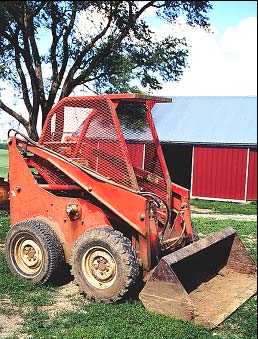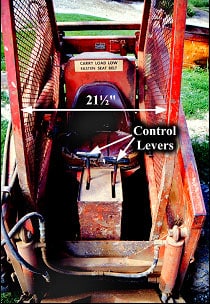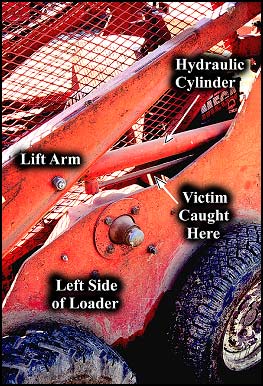Farmer Was Killed When Pinned by Old Skid-Steer Loader

SUMMARY
 |
| Photo 1 — Old skid-steer loader with ROPS cage re-attached by new owner. |
A 69-year-old farmer was found dead while cleaning snow from a hog-sorting pen. The man was driving a small skid-steer loader, which was 20-30 years old. The man was working alone, and details of the incident are unclear. He was found sitting in the operator’s seat, leaning to his left, with the left hydraulic lift arm pushing down and crushing his chest against the machine frame. The man’s hands were next to the control levers for the machine, which has led family members to suspect he may have lost consciousness prior to being pinned by the machine. There was nothing obviously in the vicinity that the man could have been reaching for. The work surface was flat concrete, and he was moving snow, as he had done many times before with the same machine. He had removed the protective cage on the machine years ago to provide access to an old-style hog house, so there was no protection between the operator and the hydraulic lift arms. He had owned this skid-steer loader for many years, and was very accustomed to using it without the cage.
RECOMMENDATIONS based on our investigation are as follows:
- Owners and operators of skid-steer loaders should not modify factory-installed protective structures, nor alter other built-in safety devices
- Owners and operators of skid-steer loaders should be made aware of the multiple dangers of using these machines.
INTRODUCTION
In February 2001, a 69-year-old farmer was killed while using a skid-steer loader at his farm. Later that week, the state Medical Examiner’s office notified the Iowa FACE program of the incident. Additional information was gathered from the County Sheriff, and a site visit was planned later in the spring. The machine had been sold to a neighbor, the same man who was one of the first to arrive at the scene. One FACE investigator visited with this man at his farm, and photographed the skid-steer loader, which had the protective cage reattached. The incident site was not visited, but relevant information was gathered from the victim’s son via telephone.
The victim was a full-time farmer and had been farming his whole life, producing grain crops and varying numbers of livestock, including hogs. The farm itself had 240 acres (97 hectares), and the farmer tilled additional rented ground for a total of 800 acres (323 hectares). At that time, the farm produced only row crops, although livestock space was occasionally rented to others. This was a typical family farm operation, and there were no safety programs or written policies in place.
INVESTIGATION
 |
| Photo 2 — Front of skid loader showing narrow ROPS cage. |
The victim was using the skid-steer loader to remove snow from a flat concrete hog lot at his farm. This was something routinely done in the winter, and the farmer had used the loader for this purpose many times. The loader was ~25-30 years old, and the victim had owned it for the past 15-20 years. The old loader was not equipped with safety interlocks as on newer machines, but did have a seatbelt, which appeared to be unused.
The height of the loader with the cage attached was 70″ (1.8 m) tall. This protective cage was too tall to accommodate an older hog house at the farm, and the farmer had removed the cage several years earlier to facilitate cleaning of manure from this building. The protective cage did not have machine controls or other mounted connections, and was therefore very easy to remove. The small loader had 28″ (71 cm) between the right and left hydraulic lift arms and only 21½” (55 cm) of space left to right inside the cage. The victim was taller and heavier than average, which likely made mounting and dismounting the narrow loader quite cumbersome, especially in the winter with heavy clothing.
The victim was found dead in the seat of the skid-steer loader, leaning to his left, with the left lift arm crushing his chest against the frame of the loader. The loader bucket was empty, and the loader was backed in position in a corner of the hog lot, as if getting ready to scoop more snow. There were no obvious gates or other objects in the vicinity that the man could have been reaching for. He may have leaned and looked to the side, or been distracted, and inadvertently grabbed one of the control levers. These circumstances are not known.
The loader was found to be in normal operating condition after this incident, and there was no evidence of any mechanical failure. Family members say the victim had recent complaints of shortness of breath, and speculate he may have suffered a heart attack or other loss of consciousness prior to the accident. No autopsy was performed, and this question can never be answered.
CAUSE OF DEATH
 |
| Photo 3 — Left side of loader showing space where victim was caught. |
The cause of death from the Medical Examiner’s report was “asphyxia due to crush injury to chest”. No autopsy was performed.
RECOMMENDATIONS / DISCUSSION
#1 Owners and operators of skid-steer loaders should not modify factor- installed protective structures, nor alter other built-in safety devices.
Discussion: The protective structure is an essential safety feature of all new skid-steer loaders. Due to close proximity to the loader bucket and lift arms, the operator is in great danger if the protective structure is removed or modified, especially on this machine, which had a very narrow distance between the lift arms. This protective cage was removed to provide easier access to an old, low farm building. Other safety features are commonly built into newer original protective cages, such as lift arm safety stops and ignition safety interlocks. This older loader had none of these features. Removal of the cage provided easier access to the machine, and to certain low worksites at the farm, but seriously compromised safety of the machine. Using the machine with the original cage would have prevented this fatality.
#2 Owners and operators of skid-steer loaders should be made aware of the multiple dangers of using these machines.
Discussion: This fatality, and several others involving skid steer loaders, indicates that increased attention is needed to address the hazards in operating skid-steer loaders. The potential to be crushed between the bucket and the frame is an obvious danger for those who choose to remove protective cages or other safety devices. Overturn hazard, seatbelt and other operator restraint use, modifications of the safety devices, and overloading the machine, are all important safety topics that should be covered. The operators should avoid walking, stepping, or leaning under the raised bucket or raised lift arms, unless the machine is turned off and mechanical lift arm stops or braces are used.
Fatality Assessment and Control Evaluation
FACE
FACE is an occupational fatality investigation and surveillance program of the National Institute for Occupational Safety and Health (NIOSH). In the state of Iowa, The University of Iowa, in conjunction with the Iowa Department of Public Health carries out the FACE program. The NIOSH head office in Morgantown, West Virginia, carries out an intramural FACE program and funds state-based programs in Alaska, California, Iowa, Kentucky, Massachusetts, Minnesota, Nebraska, New Jersey, New York, Ohio, Oklahoma, Texas, Washington, West Virginia, and Wisconsin.
The purpose of FACE is to identify all occupational fatalities in the participating states, conduct in-depth investigations on specific types of fatalities, and make recommendations regarding prevention. NIOSH collects this information nationally and publishes reports and Alerts, which are disseminated widely to the involved industries. NIOSH FACE publications are available from the NIOSH Distribution Center (1-800-35NIOSH).
Iowa FACE publishes case reports, one page Warnings, and articles in trade journals. Most of this information is posted on our web site listed below. Copies of the reports and Warnings are available by contacting our offices in Iowa City, IA.
The Iowa FACE team consists of the following: Craig Zwerling, MD, PhD, MPH, Principal Investigator; Wayne Johnson, MD, Chief Investigator; John Lundell, MA, Coordinator; Risto Rautiainen, MS, Co-Investigator.
To contact Iowa State FACE program personnel regarding State-based FACE reports, please use information listed on the Contact Sheet on the NIOSH FACE web site Please contact In-house FACE program personnel regarding In-house FACE reports and to gain assistance when State-FACE program personnel cannot be reached.
Back to NIOSH FACE Web
